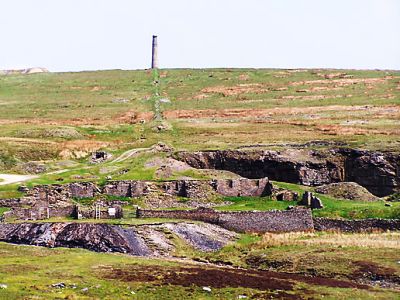 The veins at Grassington have been most productive in the Grassington Grit and the top part of the underlying Middle Limestone. Mining began around 1604 and used a system of customary law to regulate the relationship between the miners and the mineral owner. Partnerships of miners, sometimes including wealthy men, were granted units called meers (30 yards) on the line of the vein and they were free to work in return for a duty payment of one-fifth of all the lead they made. This system formed the landscape around Yarnbury and on the Out Moor where rows of shallow shafts follow the course of each vein.
The veins at Grassington have been most productive in the Grassington Grit and the top part of the underlying Middle Limestone. Mining began around 1604 and used a system of customary law to regulate the relationship between the miners and the mineral owner. Partnerships of miners, sometimes including wealthy men, were granted units called meers (30 yards) on the line of the vein and they were free to work in return for a duty payment of one-fifth of all the lead they made. This system formed the landscape around Yarnbury and on the Out Moor where rows of shallow shafts follow the course of each vein.
The first smelt mill was alongside the river Wharfe at Brow Well, near Linton Church. It was replaced in 1792 by the Cupola Mill, which stood on the edge of the Out Moor.
In 1818 the Duke of Devonshire employed John Taylor, a mining engineer and entrepreneur, to revitalise the Grassington Mines because many of them were idle, having reached the water table. Taylor, who had experience of working large, deep mines in S.W. England and North Wales, set about sinking a network of deeper shafts, some of which were fitted with pumps. A series of dams, linked by watercourses, brought water to a large new waterwheel, which drove the pumps. Horse whims were used for winding from the new shafts, and centralised dressing floors, with waterwheel-powered crushing mills, were built to serve them. A deep drainage level (adit) was also completed, but that took until 1830 to reach the veins on the Out Moor.
As well as working parts of the mines on behalf of the Duke, Taylor also leased areas to companies, with the provisos that they sank certain shafts and drove the adit through their ground when it got there. This cut the need for pumps and allowed winding drums to be fitted to the waterwheel instead. These drums held wire ropes which ran across the moor to the deeper shafts, replacing horse whims and increasing winding capacity.
By the late 1830s the mines had become very profitable and they returned large sums of money to the Duke for the next 20 years or so. Lack of economic reserves and low lead prices forced their closure in 1881.
The archaeological importance of the Grassington Mines has been recognised by English Heritage, which has scheduled large parts of them as Ancient Monuments.
Return to previous page
